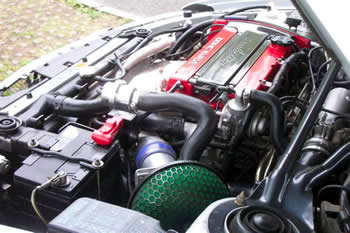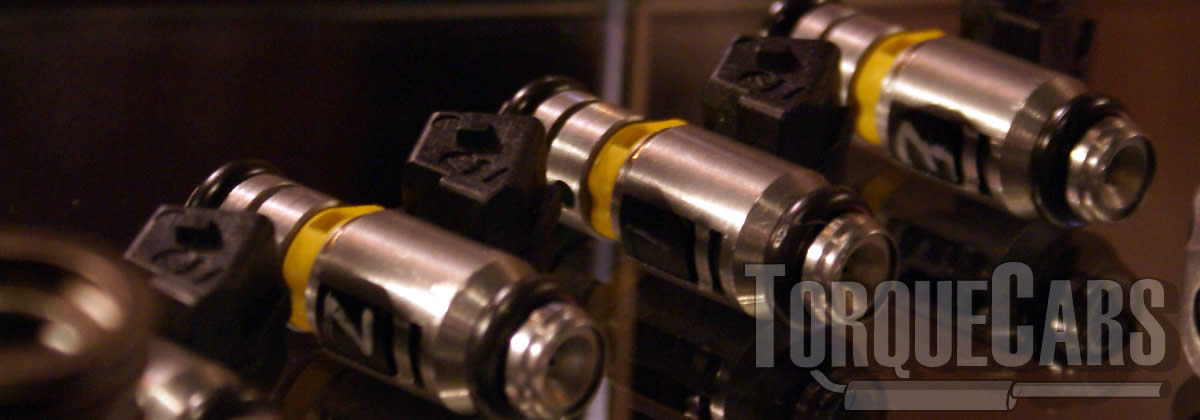Tuning the Mitsubishi 4G63
"Building the best modified Mitsubishi 4G63 engine!"
Carref prides itself on providing the latest tips and guides to your modification project.
The 4G63 is one of our most talked about engines, and for good reason.
When Rallyart took it and tuned it we saw a phenomenally powerful 2.0 4 cylinder engine. They are solid and reliable and give good returns for pretty much every mod you throw at it.
Our aim here is to detail the best approach to 4G63 tuning and highlight the premier modifications.
Mitsubishi 4G63 are good project engines and with the best sports upgrades like ECU maps, turbo improvements and camshafts you will substantially increase your driving enjoyment.
We rely on our visitors to pass on tips and tell us about their projects and what worked on their car, and this article is the culmination of the feedback we have received. First let us look at the history and specs of this engine and then consider which tuning modifications work best on it.
History of the Engine

4G63 G63B 1,997 cc (2.0 L)
- 1981-1987 Mitsubishi Lancer EX 2000 Turbo
- 1997–2000 Mitsubishi Canter
- 1988 Mitsubishi Cordia
- 1985–1998 Mitsubishi Delica
- 1990–1999 Mitsubishi Eclipse
- 1980–2003 Mitsubishi Galant
- 1992–2007 Mitsubishi Lancer Evolution
- 1993–1998 Mitsubishi Pajero
- 1994–1998 Mitsubishi RVR
- 1982–1987 Mitsubishi Starion
- 1988 Mitsubishi Tredia
- 2003-2005 Mitsubishi Airtrek
- 1999-2005 Mitsubishi Dion
- 2004–2010 Brilliance BS6
Tuning the Mitsubishi 4G63 and best 4G63 performance parts.
What are the most effective 4G63 tuning mods
The greatest 4G63 mods on an engine are obviously the ones that give the best value for money.
We won't be swayed by popular 4G63 mods, they need to be cost effective.
Significant gains on the 4G63 can be made from cam upgrades. Altering the cam profile alters the intake and exhaust durations on the engine and can dramatically change the engines power and power output.

Fast road cams normally boost the performance through the rev range, you may lose a little low end bhp but the higher rpm power will be better.
Motorsport cams, boost the higher rpm power band but as a result the car will not idle smoothly and low end power nearly always suffers.
A Race camshaft won't do well if on the daily commute.
You should ideally optimize your engines power to your usage of the car so for a car driven daily stick with a mild fast road 4G63 camshaft

Each engine responds better to different camshaft durations so set your engine up on a rolling road.
The engine timing and fuelling also will make differences on the torque gains you'll make.
Altering valve durations can alter the torque band and on most engines the exhaust and intake durations do not need to match, although most cams and tuners use matched pairs there are some advantages to extending the intake or exhaust durations.
Please watch our introduction Video tutorial to car tuning. Be sure to subscribe and support our new channel.
How to tune your car
- Improve the handling
Focus on Suspension improvements, such as coilovers and make sure the bushings are in good order and that the alignment is correct. Then focus on improving the brakes, with a big disk brake conversion kit and fast road brake pads.
- Remove restrictions
Focus on the intake and exhaust with filters being the common point of restriction in a tuned car. Intercoolers may also become restrictive on turbo engines so this may also need to be uprated.
- Burn more fuel & air
Increase the fuelling so it matches the air coming into the engine. The ratio is important so you need to improve the fuel pump and injectors, so the head mods, big valve conversions, fast road camshafts and forced induction upgrades extra supply of air is adequately met.
- Test and replace any weak parts
Weak areas are commonly the clutch, the turbocharger and pistons and crankshaft in a highly tuned engine. Makes sure these components will cope with your power aspirations.
- The Tune or Remap
A cars ECU controls the fuel, timing, spark and even the turbo in some cases, so to fully extract your gains you should remap the car last and this will fully release the power. Some cars are easy to map, and others require piggyback ECU's or aftermarket ECU's but this is the most vital step of your tuning project.
Modifying to Stage 1:
Sports exhaust manifold, Drilled & smoothed airbox, Fast road camshaft, Remaps/piggy back ECU, Intake headers, Panel air filters.
Modifying to Stage 2:
induction kit, fuel pump upgrades, Ported and polished head, high flow fuel injectors, Fast road cam, Sports catalyst & performance exhaust.
Modifying to Stage 3:
Crank and Piston upgrades to alter compression, Twin charging conversions, Internal engine upgrades (head flowing porting/bigger valves), Competition cam, Engine balancing & blueprinting, Adding or Upgrading forced induction (turbo/supercharger).
A remap helps fully realize the full potential of all the tuning parts you've done to your 4G63.
It will usually give around 30% more power on turbocharged vehicles and you can expect to see around 15% on NASP engines, but your results may depend much on the tuning parts you've carried out and the condition of your engine.
It is the aim to any car tuning job to pull more air and fuel into your 4G63
Intake headers take the air from the filter and allow it to be drawn into the engine and mixed with fuel.
The shape and flow rate of the Intake headers can make a substantial improvement to fuel delivery on the 4G63.
Commonly we find the intake are in desperate need of aftermarket parts, although a few car makers provide reasonably good intake.
Increasing the 4G63 valve size, doing a bit of 3 or 5 angle valve jobs and porting and head flowing will also increase performance, and significantly will give you increasing the performance increase on other tuning mods.
Which turbo upgrades are best?

NASP engines need quite a lot of work when you add a turbo, so we have a separate guide to help you take into account the pros and cons of going this route on your 4G63
The more air you can get into an engine, the more fuel it can burn and uprating the induction with a turbocharger upgrade makes significant power gains.
If the engine has a turbocharger tuning parts are giving better power gains and turbocharged engines use better components.
However most engines will need better parts at higher power limits
See where you'll find these restrictions and upgrade to more solid crank and pistons to utilize the power.
There are many drivers spending a lot of money on turbo charger upgrades on the 4G63 only to suffer the humiliation of seeing the 4G63 explode just after it's been completed.
Larger turbo chargers tend to suffer low end lag, and little turbo chargers spool up really quickly but won't have the top end power band gains.
In the last 10 years the selection of turbo chargers is always moving on and we now see variable vane turbo chargers, where the vane angle is altered according to speed to lower lag and increase top end power.
Twin scroll turbo chargers divert the exhaust flow into two channels and push these at differently angled vanes in the turbocharger. They also improve the scavenging effect of the engine.
It is common that there is a limitation in the air flow sensor MAF/MAP on the 4G63 when a lot more air is being sucked into the engine.
Going up you'll find 4 bar air sensors coping with quite large power gains, whereas the OEM air sensor was restricting bhp at a much lower level.
Adding a supercharger or additional turbo will make large power gains, although more difficult to setup. We have this feature on twinchargers if you want to read more.
Fuelling
You will need to ensure that the engine is not starved of fuel so should ramp up the fuelling when you start exceeding 20% of a bhp and torque increase. Most tuners we speak with say to be generous with your injectors flow rate.
Most tuners we speak with say to be generous with your injectors flow rate.
As a rule of thumb add 20% when fitting an injector, which takes into account injector deterioration and allows you some spare capacity should the engine require more fuel.
We think this one is common sense, but you'll need to match your fuel injector to the type of fuel your car uses as well.
All the following flywheel power targets will assume an injector duty cycle of 80% and a base of 58psi of fuel pressure at idle.
4 Cylinder turbocharged engines
- 58 PSI 340cc/min 200hp
- 58 PSI 511cc/min 300hp
- 58 PSI 682cc/min 400hp
- 58 PSI 1022cc/min 600hp
4 Cylinder NASP engines
- 58 PSI 285cc/min 200hp
- 58 PSI 426cc/min 300hp
4 Cylinder supercharged engines
- 58 PSI 312cc/min 200hp
- 58 PSI 468cc/min 300hp
- 58 PSI 625cc/min 400hp
- 58 PSI 937cc/min 600hp
Choosing the right performance exhaust
One of the most common mistakes and problems we see in tuning projects is usually down to the exhaust, or rather a poorly chosen exhaust for your engine.
You should look to increase your exhaust if your exhaust is actually creating a flow problem.
On most factory exhausts you should find that the flow rate is good even on modest power gains, but when you start pushing up the power levels you will need to get a better flowing exhaust.
Note that with the widest exhaust you can buy you'll slow the exhaust rate - the best exhausts for power gains are usually between 1.5 to 2.5 inches. It is the shape and material more than the bore size.
Typically exhaust restrictions are in the filters installed, so adding a freer flowing performance alternative will help avoid this restriction.
Weak spots Issues & problem areas on the 4G63
The 4G63 engines are generally reliable and solid as long as they are regularly serviced and maintained.
Regular oil changes are vital on the 4G63, especially when tuned and will help extend the life and reliability of the engine.
For more information on Tuning your 4G63 engine please join us in our friendly forum where you can discuss tuning options in more detail with our 4G63 owners. It would also be worth reading our unbiased tuning articles to get a full grasp of the benefits and drawbacks of each modification.
Please help us improve these tips by sending us your feedback in the comments box below.
We love to hear what our visitors have got up to and which upgrades work best for them on each model of car. Comments are used to improve the accuracy of these 4G63 articles which are continually updated.
If you liked this page please share it with your friends, drop a link to it in your favourite forum or use the bookmarking options to save it to your social media profile.
Check out TorqueCars new YouTube channel, and see their awesome new content...
Feedback
Please use our forums if you wish to ask a tuning question, and please note we do not sell parts or services, we are just an online magazine.
Help us improve, leave a suggestion or tip
